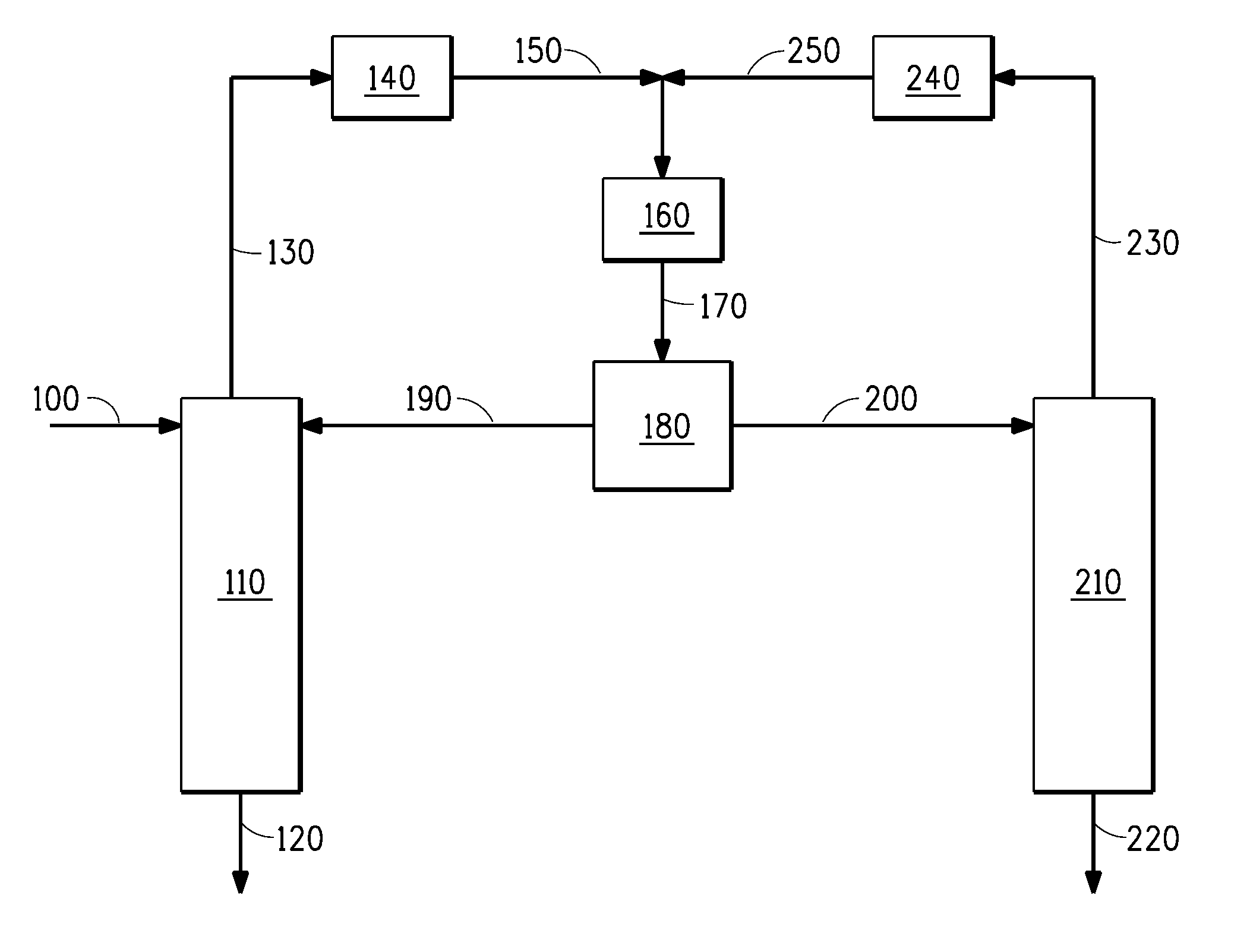Processes for separation of 2,3,3,3-tetrafluoropropene from hydrogen fluoride by azeotropic distillation
a technology of tetrafluoropropene and hf, which is applied in the separation process, vacuum distillation separation, halogenated hydrocarbon preparation, etc., can solve the problems of difficult separation of fluoroolefins and hf, ineffective separation of these compounds by existing distillation and decantation methods, and large amount of scrubbing solutions
- Summary
- Abstract
- Description
- Claims
- Application Information
AI Technical Summary
Problems solved by technology
Method used
Image
Examples
example 1
Synthesis of HFC-1234yf by Dehydrofluorination with Fluorided Alumina Catalyst
[0150]A Hastelloy® tube reactor (1.0″ OD×0.854″ ID×9.5″ L) was filled with 25 cc of gamma-alumina ground to 12-20 mesh. The packed portion of the reactor was heated by a 5″×1″ ceramic band heater clamped to the outside of the reactor. A thermocouple, positioned between the reactor wall and the heater measured the reactor temperature. The catalyst was dried by heating at 200° C. for 15 minutes under a nitrogen purge and then reacted with a HF / N2 mixture heated up to 425° C. to yield 16.7 gm of activated fluorided alumina.
[0151]At a temperature of 350° C., 10 sccm of nitrogen (1.7×10−7 m3 / s) and 15 sccm (2.5×10−7 m3 / s) of HFC-245cb (CF3CF2CH3) were mixed and flowed through the reactor. The temperature was then raised to 400° C., the flow rates held constant. The effluent for both temperatures was sampled and analyzed by 19F NMR. Additionally, the effluent was analyzed by GC / FID to determine concentrations as...
example 2
Synthesis of HFC-1234yf with Carbon Catalyst
[0152]To a Hastelloy® nickel alloy reactor (1.0 OD×0.854″ ID×9.5″ L) was charged 14.5 g (25 mL) of spherical (8 mesh) three dimensional matrix porous carbonaceous material prepared substantially as described in U.S. Pat. No. 4,978,649, incorporated herein by reference. The packed portion of the reactor was heated by a 5″×1″ ceramic band heater clamped to the outside of the reactor. A thermocouple, positioned between the reactor wall and the heater measured the reactor temperature.
[0153]At a temperature of 400° C., 10 sccm (1.7×10−7 m3 / s) of nitrogen and 15 sccm (2.5×10−7 m3 / s) of HFC-245cb (CF3CF2CH3) were mixed and flowed through the reactor giving a contact time of 60 seconds. The flows were then reduced to 5 sccm of nitrogen (8.3×10−8 m3 / s) and 7.5 sccm (1.3×10−7 m3 / s) of HFC-245cb (CF3CF2CH3) giving a contact time of 120 seconds. The effluent was sampled under both sets of conditions and analyzed by 19F NMR. Additionally, the effluent ...
example 3
Azeotropic Distillation for the Separation of HFC-1234yf from HF Without an Entrainer
[0154]Example 3 demonstrates that HF may be separated from HFC-1234yf by azeotropic distillation with no entrainer. Referring now to FIG. 1, a composition comprising HF and HFC-1234yf is fed to a first column 110 via stream 100. This first column contains 8 theoretical stages and is operated under appropriate conditions to approach the low-boiling HF / HFC-1234yf azeotrope. Because HF is being fed to this first column in excess of that needed to form the azeotrope with the HFC-1234yf, HF is recovered as a product stream out the bottoms of the column via stream 120, while a composition near to the HF / HFC-1234yf azeotrope is recovered as distillate via stream 130. Stream 130 is condensed in 140, mixed with the nearly azeotropic composition recycled from the second column via stream 250 and the combined stream is sub-cooled in cooler 160 and sent to decanter 180 where the combined stream 170 separates in...
PUM
| Property | Measurement | Unit |
|---|---|---|
| Temperature | aaaaa | aaaaa |
| Temperature | aaaaa | aaaaa |
| Fraction | aaaaa | aaaaa |
Abstract
Description
Claims
Application Information
 Login to View More
Login to View More - R&D
- Intellectual Property
- Life Sciences
- Materials
- Tech Scout
- Unparalleled Data Quality
- Higher Quality Content
- 60% Fewer Hallucinations
Browse by: Latest US Patents, China's latest patents, Technical Efficacy Thesaurus, Application Domain, Technology Topic, Popular Technical Reports.
© 2025 PatSnap. All rights reserved.Legal|Privacy policy|Modern Slavery Act Transparency Statement|Sitemap|About US| Contact US: help@patsnap.com



